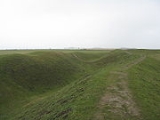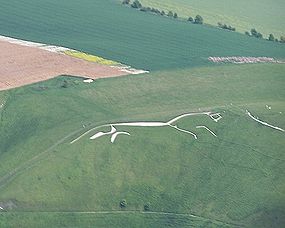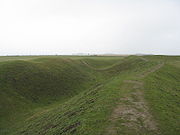
Uffington Castle
Encyclopedia
Uffington Castle is all that remains of an early Iron Age
(with underlying Bronze Age
) hill fort
in Oxfordshire
, England
. It covers about 32,000 square metres and is surrounded by two earth banks separated by a ditch with an entrance in the eastern end. A second entrance in the western end was apparently blocked up a few centuries after it was built .


 The original defensive ditch was V-shaped with a small box rampart in front and a larger one behind it. Timber posts stood on the ramparts. Later the ditch was deepened and the extra material dumped on top of the ramparts to increase their size. A parapet wall of sarsen
The original defensive ditch was V-shaped with a small box rampart in front and a larger one behind it. Timber posts stood on the ramparts. Later the ditch was deepened and the extra material dumped on top of the ramparts to increase their size. A parapet wall of sarsen
stones lined the top of the innermost rampart. It is very close to the Uffington White Horse
.
Excavations have indicated that it was probably built in the 7th or 8th century BC and continued to be occupied throughout the Iron Age. Isolated posthole
s were found inside the fort but no evidence of buildings. Pottery, loom weights and animal bone finds suggest some form of occupation however.
The most activity appears to have been during the Roman period as the artefact
s recovered from the upper fills of the ditch attest. The ramparts were remodelled to provide more entrances and a shrine seems to have been built in the early 4th century AD.
Two oblong mounds, one containing 46 Romano-British
burials and one containing 8 Saxon burials, lie nearby.
Iron Age
The Iron Age is the archaeological period generally occurring after the Bronze Age, marked by the prevalent use of iron. The early period of the age is characterized by the widespread use of iron or steel. The adoption of such material coincided with other changes in society, including differing...
(with underlying Bronze Age
Bronze Age
The Bronze Age is a period characterized by the use of copper and its alloy bronze as the chief hard materials in the manufacture of some implements and weapons. Chronologically, it stands between the Stone Age and Iron Age...
) hill fort
Hill fort
A hill fort is a type of earthworks used as a fortified refuge or defended settlement, located to exploit a rise in elevation for defensive advantage. They are typically European and of the Bronze and Iron Ages. Some were used in the post-Roman period...
in Oxfordshire
Oxfordshire
Oxfordshire is a county in the South East region of England, bordering on Warwickshire and Northamptonshire , Buckinghamshire , Berkshire , Wiltshire and Gloucestershire ....
, England
England
England is a country that is part of the United Kingdom. It shares land borders with Scotland to the north and Wales to the west; the Irish Sea is to the north west, the Celtic Sea to the south west, with the North Sea to the east and the English Channel to the south separating it from continental...
. It covers about 32,000 square metres and is surrounded by two earth banks separated by a ditch with an entrance in the eastern end. A second entrance in the western end was apparently blocked up a few centuries after it was built .



Sarsen
Sarsen stones are sandstone blocks found in quantity in the United Kingdom on Salisbury Plain, the Marlborough Downs, in Kent, and in smaller quantities in Berkshire, Essex, Oxfordshire, Dorset and Hampshire...
stones lined the top of the innermost rampart. It is very close to the Uffington White Horse
Uffington White Horse
The Uffington White Horse is a highly stylised prehistoric hill figure, 110 m long , formed from deep trenches filled with crushed white chalk...
.
Excavations have indicated that it was probably built in the 7th or 8th century BC and continued to be occupied throughout the Iron Age. Isolated posthole
Posthole
In archaeology a posthole is a cut feature used to hold a surface timber or stone. They are usually much deeper than they are wide although truncation may not make this apparent....
s were found inside the fort but no evidence of buildings. Pottery, loom weights and animal bone finds suggest some form of occupation however.
The most activity appears to have been during the Roman period as the artefact
Artifact (archaeology)
An artifact or artefact is "something made or given shape by man, such as a tool or a work of art, esp an object of archaeological interest"...
s recovered from the upper fills of the ditch attest. The ramparts were remodelled to provide more entrances and a shrine seems to have been built in the early 4th century AD.
Two oblong mounds, one containing 46 Romano-British
Romano-British
Romano-British culture describes the culture that arose in Britain under the Roman Empire following the Roman conquest of AD 43 and the creation of the province of Britannia. It arose as a fusion of the imported Roman culture with that of the indigenous Britons, a people of Celtic language and...
burials and one containing 8 Saxon burials, lie nearby.
External links
- Ancient Britain - Uffington Castle
- http://www.youtube.com/watch?v=ZcRNKkkAWO8
- Research data: Wessex Hillforts Survey - extensive three-year study by English Heritage and Oxford University
See also
- Wayland's SmithyWayland's SmithyWayland's Smithy is a Neolithic long barrow and chamber tomb site located near the Uffington White Horse and Uffington Castle, at Ashbury in the English county of Oxfordshire ....
- White Horse Hill

